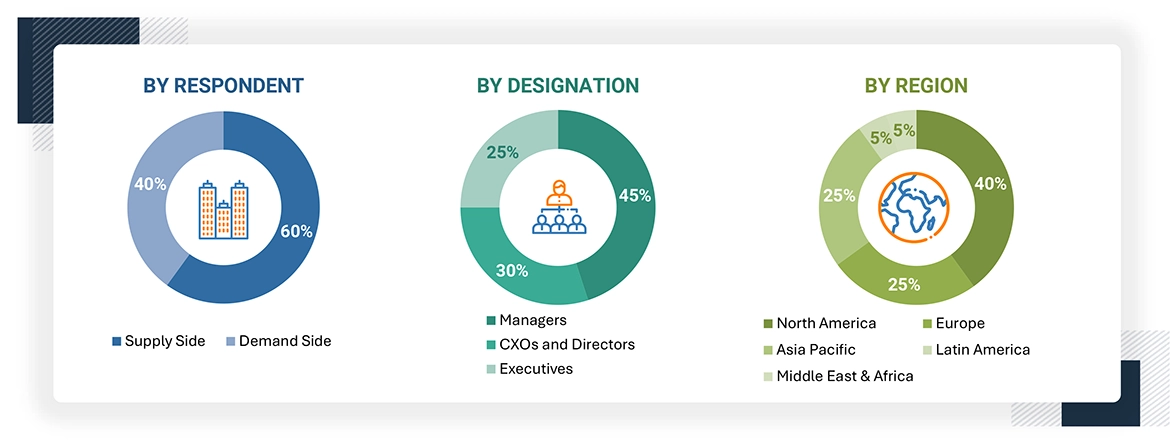This study on the spatial genomics & transcriptomics market employed secondary sources, directories, and databases to gather pertinent information. To gather and validate important qualitative and quantitative data and evaluate market growth prospects, in-depth interviews were conducted with many primary respondents including key industry participants, subject-matter experts (SMEs), C-level executives from key market players, and industry consultants. After estimating the spatial genomics & transcriptomics market using several research strategies, the size of the final market was obtained by triangulating data from primary research.
Secondary Research
The secondary sources referred to for this research study include publications from government sources, such as World Health Organization (WHO), National Institutes of Health (NIH), Organisation for Economic Co-operation and Development (OECD), International Agency for Research on Cancer (IARC), Research!America, Genome Canada, GenomeWeb, South African Medical Research Council (SAMRC), Wellcome Sanger Institute, Genome Research Limited, Labiotech.eu, R&D World Magazine, India Brand Equity Foundation (IBEF), Biotechnology Innovation Organization (BIO), National Center for Biotechnology Information (NCBI), BioPharm International, EvaluatePharma, ScienceDirect, Eurostat. Secondary sources include corporate and regulatory filings, such as annual reports, SEC filings, investor presentations, and financial statements; business magazines & research journals; press releases; and trade, business, and professional associations. Secondary data was collected and analyzed to arrive at the overall size of the global spatial genomics & transcriptomics market, which was validated through primary research.
Primary Research
Extensive primary research was conducted after acquiring basic knowledge about the global spatial genomics & transcriptomics market scenario through secondary research. Several primary interviews were conducted with market experts from the supply side, such as C-level and D-level executives, operational managers, marketing & sales managers of key manufacturers, distributors, and channel partners of companies providing gene editing products and services; experts from the demand side, such as personnel from pharmaceutical & biotechnology companies, Academic & research institutes, clinical diagnostic laboratories, and CROs & CDMOs. These interviews were conducted across six major regions, including North America, Europe, the Asia Pacific, Latin America, the Middle East, and Africa. Approximately 70% and 30% of the primary interviews were conducted with supply-side and demand-side participants, respectively. This primary data was collected through questionnaires, e-mails, online surveys, personal interviews, and telephonic interviews.
The following is a breakdown of the primary respondents:

To know about the assumptions considered for the study, download the pdf brochure
Market Size Estimation
Both top-down and bottom-up approaches were used to estimate and validate the total size of the spatial genomics & transcriptomics market. These methods were also used extensively to estimate the size of various subsegments in the market. The research methodology used to estimate the market size includes the following:
Bottom-up Approach
-
The key players in the industry and market have been identified through extensive secondary research.
-
The revenues generated from the spatial genomics & transcriptomics market business of leading players have been determined through primary and secondary research.
-
All percentage shares, splits, and breakdowns have been determined using secondary sources and verified through primary sources.
Top-down Approach
After arriving at the overall market size from the market size estimation process, the total market was split into several segments and subsegments.
Data Triangulation
To complete the overall market engineering process and arrive at the exact statistics for all segments and subsegments, data triangulation and market breakdown procedures were employed, wherever applicable. The data was triangulated by studying various factors and trends from both the demand and supply sides.
Market Definition
The spatial genomics & transcriptomics market, as covered within the scope of this report, includes products, technologies, and services that facilitate spatial genomics & transcriptomics across various applications. Spatial genomics and transcriptomics are pioneering technologies that allow scientists to measure the gene activity in a tissue sample and map the site of the activity. Spatial transcriptomics helps spatially resolve RNA-seq data and all mRNAs in individual tissue sections. The technology is presently used in translational research and can be used in clinical diagnosis in the future. Spatial genomics also helps map gene expressions across human tissues.
Stakeholders
-
Manufacturers and distributors of spatial genomics and transcriptomics products
-
Spatial genomics and transcriptomics service providers
-
Pharmaceutical and biotechnology companies
-
Contract research organizations (CROs)
-
Contract Development & Manufacturing Organizations (CDMOs)
-
Market research and consulting firms
-
R&D centers
-
Researchers and scientists
-
Academic & research institutes
-
Market Research and Consulting Firms
-
Regulatory Agencies
-
Venture Capitalists
-
Government Organizations
-
Industry Associations and Professional Societies
-
Diagnostic companies
Report Objectives
-
To define, describe, segment, and forecast the spatial genomics & transcriptomics market based on offering, technique, application, type (service), end user (product), end user (service), and region
-
To provide detailed information about the factors influencing market growth, such as drivers, restraints, opportunities, and challenges
-
To strategically analyze micromarkets1 with respect to individual growth trends, prospects, and contributions to the overall gene editing market
-
To analyze market opportunities for stakeholders and provide details of the competitive landscape for key players
-
To forecast the size of the market segments concerning six main regions: North America, Europe, the Asia Pacific, Latin America, the Middle East, and Africa.
-
To strategically profile the key players in the global spatial genomics & transcriptomics market and comprehensively analyze their core competencies2 and market rankings.
-
To track and analyze competitive developments, such as product & service launches, acquisitions, collaborations, expansions, and partnerships in the gene editing market.
-
To profile the key players in the global spatial genomics & transcriptomics market and comprehensively analyze their product and services portfolios, market positions, and core competencies
-
To track and analyze competitive developments such as product & service launches, expansions, agreements, and collaborations in the spatial genomics & transcriptomics market
-
To benchmark players within the spatial genomics & transcriptomics market using the ‘Company Evaluation Matrix' framework, which analyzes market players based on various parameters within the broad categories of business and service strategy.



Growth opportunities and latent adjacency in Spatial Genomics & Transcriptomics Market